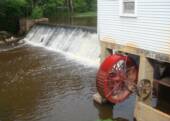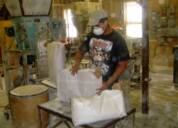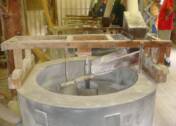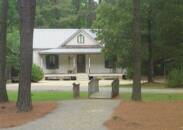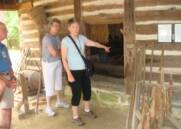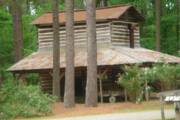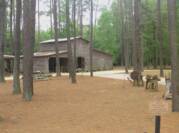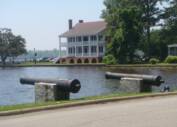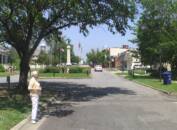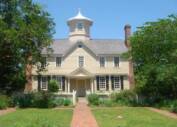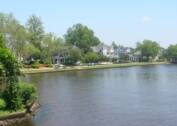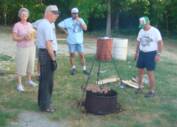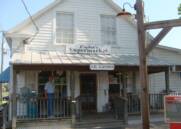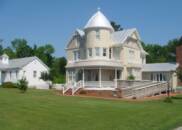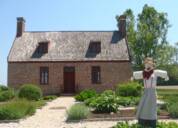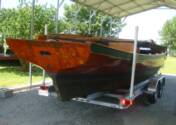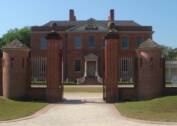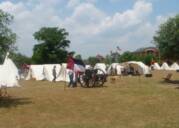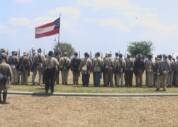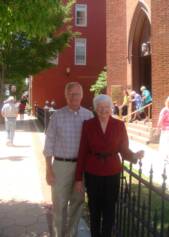Sunday, May 2nd - We drove in to the First Baptist Church of Smithfield for their worship service. This was a large traditional Baptist church from the building design to the order of worship. 11:00am service, no screens, no band instruments, no 7-11 songs - just traditional hymns, organ and piano music, and a short sermon. The sanctuary was designed in a deep rectangle with 30 foot high ceilings - ten large stained glass windows, four large chandeliers, and an impressive array of organ pipes.
A festival was underway in town with many antique cars on display and a large number of vendors of all kinds. It was called the Ham and Yam Festival, but we didn't see any ham or sweet potatoes. We walked around a bit, then looked for some air conditioned space with lunch at the local Applebees restaurant. Hot weather continues.
Monday, May 3rd - Two things were on our agenda for this day - Atkinson’s old grist mill near Selma, NC and the Tobacco Farm Life Museum near Kenly, NC. The old grist mill has been in operation continuously since 1757, using water power from the Little River in Johnston County. The mill was first built by a man named John Richardson and remained in the hands of the Richardson family for over 200 years. In 1971 it was sold to an employee, Ray Wheeler, who led us on a tour of the facility. At one point he was the only employee. Now there are over 60 employees. Not only do they continue to grind corn, but they mix the milled corn with other products and market over 80 different products - all sold within 10 nearby counties of North Carolina. It was a busy place with semi-trucks coming and going through the complex.
The Atkinson name comes from Dr. Wade Atkinson, a Richardson descendant, who gained fame as a physician in Washington, DC. He inherited the mill and was the first owner to build a dam to better harness the power of the river.
At one time there were hundreds of grist mills in the state, but now there only five, and Atkinson’s is the only one left using water power. It will soon become a museum as the company is building a new modern electric powered mill on the property. One of the company’s products is frozen hush puppies, and Mr. Wheeler brought over a package just out of the cooker for us to sample.
One of the interesting facts we learned was that the large grinding wheels which can last 100 years come from France - the only place in the world where this particular stone is found. Another interesting fact about their market - 99% of their customers prefer meal from white corn instead of yellow. This caravan stop was another example of seeing something on caravan that we would never have known about otherwise.
After lunch we drove to the little town of Kenly - Friendly Kenly - for a visit to the Tobacco Farm Life Museum, Their goal is “to preserve the history and cultural heritage of the eastern North Carolina farm family.” We began our tour watching a video of a modern tobacco farm. The automation now possible is incredible. Farm subsidies for tobacco and tobacco allotments have without much fanfare been discontinued. The return to natural competition has eliminated all but the well financed farms who can afford the modern equipment. The video was in marked contrast with the old ways of farming displayed so well by the museum.
An old farm cabin, a newer home of the 1930s, barns, blacksmith shop, and an old school building were set among a forest of huge pine trees. The museum itself was in a large building with all sorts of artifacts from the Depression era and before - both home furnishings and farm implements. It was all from a time before electricity and modern plumbing had come to the area. That was also a time when families were larger, had strong ties to each other, worked hard, and were spiritually oriented.
The primary focus was on agriculture because that was the economic base in the early 1900s. One area showed how tobacco was grown, harvested, cured, and sold, with an auctioneer rattling off his singsong chant. There were also exhibits about growing sweet potatoes, cotton, and soybeans - those crops that were rotated with the tobacco, but tobacco was the principle farm product.
This museum was opened in 1983. Our tour guide was a young lady who really knew her stuff. She did a good job of explaining all the exhibits and made it all come alive. We were probably the oldest of the groups she was used to guiding through. She, no doubt, was great with the children who go through, but there were none of them on this day. In one of the cabins, she discovered that a colony of bees had taken up residency. She was adamant that they would not be killed, but promised to call someone who would move them to his hives. It was a very interesting tour, and again, something we would never have known about or thought to visit had we been out traveling without the caravan.
Tuesday, May 4th - Moving day again, this time 135 miles eastward to Rocky Hock, NC. Rocky Hock is near Edenton at the headwaters of Albemarle Sound. It was a three hour drive through flat countryside. This is the next to last stop on the caravan as we wind down the adventure - shorter than most caravans..
The caravan ate together at a local seafood buffet - Nixons Family Restaurant. Fried chicken, oysters, shrimp, scallops, fish, along with barbecued pork and ribs, also corn, cabbage, butter beans, and more. The restaurant opened just for us, so we had all that to ourselves.
Wednesday, May 5th - Edenton, NC is an historic little town, dating back almost 300 years. First laid out in 1712 and incorporated ten years later, it was the first capital of colonial North Carolina and NC's second oldest city, named after a British governor, Charles Eden. A tour trolley was awaiting us as we arrived at the Visitors Center, and a charming lady told the history of the town as we rolled past many old homes, churches, cemeteries, and government buildings. After forty minutes on the tram, we then visited an old home called the Iredell House - once the home of one of the original Supreme Court Justices, James Iredell. It was a very nice day - clear sky and not too hot.
At one time during the 1700s Edenton was a thriving port city, but a hurricane in 1795 changed the depth of the water making it impossible for ocean going vessels to reach the city. The old houses reflected a remarkable style of architecture, but there is marked deterioration. While some restoration has been done, the need for more is quite apparent. One old building was just recently (this past April) blown off its foundation.
Back during the Revolution, North Carolina had it own Tea Party. Though not as famous as the Boston Tea Party, the Edenton Tea Pary was a rebellion just as valid. It was unusual because the leading organizer was a woman - a woman named Penelope Barker. Her home was one of the more elaborate homes.
After lunch at the The Edenton Coffee House we did a short walking tour around the downtown and waterfront area. On a tour of the Barker House, we learned more about the Edenton Tea Party and the 51 women who organized it. They were protesting the tax on tea and cloth imposed by the British king.
Activities for the day ended with a steak cookout back at camp. Jim Matkovitch cooked ribeyes for everyone with his tripod supported grill over a wood fire while the ladies put together salad and a potato casserole. We enjoyed all that with Ice cream after in the new red barn at the camp. On weekends folks come from all around to hear country music in the barn.
Thursday, May 6th - The was a free day from caravan activities. Folks scattered around the area taking in the sights. What we did was interesting, though not exciting. We first drove about twelve miles to the little town of Hertford and had icecream at the local drug store. Hertford is in Perquimans County. Strange names around here.
The adjoining counties are Chowan and Pasquotank. There's the Yeopim River, the villages of Chapanoke and Winfall - presumably all drived from local Indian tribes,
At the Welcome Center a friendly lady gave advice on what to see in the area. A room in the center was devoted to the memory of Jim "Catfish" Hunter, the American League pitcher who set records for the Athletics and Yankees for fifteen years in the late 60s and 70s. No one knew him as "Catfish" when he was growing up in Hertford. He was just Jimmy Hunter. He had over 200 victories in his major league career.
From Hertford we crossed the Perquimans River on the "S" bridge to Belvidere and Layden's Super Market. The little market was unique, but hardly "super." They smoked their own meat, and had a lot of it hanging in the store. They ground their own sausage, cut their own steaks and pork chops, and offered more friendly advice on what was around to see. Just down the road was the Nicholson House - a charming old house that is now a tea house.
Next we drove back through Hertford to an old Quaker house built in 1730 called the Newbold-White House. This is the oldest brick house in North Carolina. A very knowledgable lady, a descendant of slaves, showed us through the house and grounds. This old plantation backed up to the river which was used in the old days for transporting the plantation produce to market.
We watched a video about the construction of a periauger boat, the riverboat style used back when. A periauger is traditionally made from two cypress trees, hollowed and joined by a verticaly placed board that serves as a keel. An old periauger, dug up on the property, was on display in the Welcome center. A recently constructed sea worthy periauger was there on the property - used on reinactment days. It is propelled by sails, or by oars if there is no wind.
Then we drove back to Edenton for lunch at Chero's, next to the public library where this was written and uploaded using the library's wifi system.
Friday, May 7th - Moving day. From Rocky Hock we followed SR17 southward for 100 miles to New Bern and the New Bern KOA for our final stop. We were de-parkers along with Carl and Sandy Nunn, meaning that we checked everyone else out of the Rocky Hock Campground, making sure that steps were up, antennaes down, hitches properly installed, turn signals and brake lights working, etc. - a safety measure common to all caravans. That made us the last to leave, but we still had to stall our arrival time to the new campground for an hour to allow the parkers time to get organized. This KOA is the nicest campground of the trip. Right on the banks of the Neuse River, our site has a nice patio, an umbrella over the picnic table, a dome shaped fire box, and a shade tree.
A catered dinner of brunswick stew, fried chicken, barbecue, and the trimmings was ready for us in the meeting room close to where we were parked. After that we enjoyed a sunset off the pier that reached out into the river.
Saturday, May 8th - In colonial days the Tryon Palace in New Bern was to North Carolina as the Governor's Palace in Williamsburg was to Virginia. Not sure when the capitol was moved from Edenton to New Bern, but Governor William Tryon probably had an inflated view of his position when he built these elaborate buildings between 1767 and 1770. He did not have the favor of the English king and was moved to New York shortly after the buildings were completed. Then, after the successful American Revolution, the capitol was moved to Raleigh, and these buildings fell into disarray. A fire in 1798 virtually destroyed the entire complex. In the ensuing 150 years, the property was subdivided into small lots and sold off, and a highway was built right over where the palace once stood.
Restoring the Tryon Palace seemed like an impossibility in the late 1940s, but a group of ladies in New Bern led by Mrs. Maude Moore Latham successfully undertook the challenge. The hurdles they overcame make a remarkable story. They convinced the political authorities to close the highway. They found the money to buy up most of the original property. They found the plans drawn by the original architect and found an inventory of Governor Tryon's furnishings. Then, Mrs. Latham used the money inherited from her wealthy husband to finance the reconstruction.
A lady in period costume conducted our tour through the several floors of the palace, explaining the faith to the original plans that the rebuilders followed. The furnishings are true to the period in which the Tryon family lived there. After visiting some other old houses nearby, we had lunch at Chadwicks, a quaint little home cooking restaurant in the palace neighborhood.
A Civil War re-enactment was underway at a park near the waterfront. Tents were erected for the participants. We witnessed a parade of poorly uniformed troops marching to drumbeat. Those troops then lined up to fire off two volleys of rifle fire.
Cannons were being set up around the park. As we strolled down the old historic part of town, many of the re-enactors were strolling along too - often Blue and Gray soldiers walking along together.
The caravaners met at the Cow Cafe for icecream at 4:00pm and at 6:00pm back at the campground, many of our group took part in a spaghetti dinner put on by the KOA folks.
Sunday, May 9th - It was cooler on this day - in the 70s instead of 90s - still with clear skies. We went in to New Bern to the First Baptist Church, then had a grouper lunch at Captain Ratty's Restaurant, sharing the meal with Kay and Devin Bowman. Established in 1809, the church appeared to be a large church, but it was smaller inside than it first appeared. The service was more formal than most. The Pastor and three associates, one of which was a woman, all wore robes. Since it was Mother's Day all the mothers were recognized and received a red carnation.
Monday, May 10th - The day began with breakfast at Roy's Family Restaurant, just down the road apiece from the campground. It was a good meal, but when our group of 24 people went in all at once, it overwhelmed the cook, and that resulted in rather slow service - and it was loud with everyone talking at once. Afterward, we drove out to the new mall west of New Bern, though not many stores were yet open. Stopped in Walmart to buy some things to make our TV work better.
Then we took a drive to the little seaport town of Oriental, the home of our leaders, the Kings. Oriental claims to be the sail boat capital of North Carolina. It is certainly in an appropriate spot for that right on the Pamlico Sound. There was almost no activity going on. Shops were closed. Few people moving around. It was a small place. Maybe they take Monday off.
This was the last full day of the caravan with a final banquet set for the evening. So back to New Bern we went for that - to the Chelsea Restaurant. The meal was good, and the fellowship super, though saying good-bye was tough as usual at the end of a caravan. Kay Bowman read a poem she had written that captured the essence of all our activities. Then, it was over.
